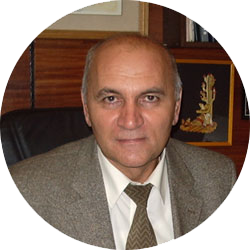RF Patent # 2088693. Filed 9.02.1996, published 27.08.1997.
Bakhir V.M. and Zadorozhny Yu.G.
This invention protected by RF patent # 2088693 was the first publication in patent literature about a new technological process – ion-selective electrolysis with diaphragm and a device for implementation of the process. The essence of the process is electrochemical decomposition of a concentrated sodium chloride solution followed by generation of anodic oxidation products in the form of a gaseous mixture of oxidants – chlorine, chlorine dioxide and ozone, as well as products of cathodic reduction in the form of a concentrated (150-170 g/l) sodium hydroxide solution without preliminary conditioning of initial sodium chloride aqueous solution (only rough cleaning from hardness salts is needed) and intermediate (in the process of electrolysis) continuous conditioning of anolyte and catholyte in electrochemical reactor with ceramic inert microporous diaphragm. The technology of ion-selective electrolysis (ISED) was developed as an alternative to well-known technological processes of chlorine synthesis: electrolysis with a mercury cathode, electrolysis with diaphragm, and electrolysis with ion-selective membrane.
The ISED technology was first realized in device called AQUACHLOR, and was meant for highly efficient and ecologically safe synthesis of a mixture of gaseous products – chlorine (95%), chlorine dioxide (3%), ozone (2%), as well as sodium hydroxide solution (150-170 g/l) from sodium chloride solution (200-250 g/l). The end products of AQUACHLOR devices are acid (with рН 2.5-3.5) solution of above-mentioned oxidants in water with concentration from 0.5 to 2.0 g/l (an analogue of chlorine water generated in chlorinators at water treatment plants during gaseous chlorine introduction in water) and sodium hydroxide solution of 150-170-g/l concentration.
AQUACHLOR device is supplied with electrochemical reactor of RPE type made as a combination of hydraulically connected in parallel FEM flow-through electrolytic modular cells, an appliance for feeding salt solution under pressure up to 2 kgf/cm2 into electrochemical reactor, and a current power supply. Anodic and cathodic electrode chambers of the reactor are hydraulically connected with anodic and cathodic circulation capacities. The anodic capacity of circulation circuit is fitted with upstream pressure controller. In the process of the device’s operation, a saturated sodium chloride solution under pressure is dosed into the anodic chamber of electrochemical reactor. This solution circulates throughout anodic chamber thanks to gas lift: gases liberated on anode – chlorine and chlorine dioxide – take liquid up with them, to a capacity where gas is separated from liquid. Gaseous mixture is removed from the upper part of the capacity, and the liquid returns to the inlet into anodic chamber. The pressure in the reactor’s anodic chamber is 0.5-1.0 kgf/cm2 higher than that in the cathodic one, preventing hydroxide ions from penetration from cathodic to anodic chamber and in this way increasing chlorine gas current output. Under the action of differential pressure and due to electro-diffusion transfer, sodium ions penetrate from anodic to cathodic chamber through diaphragm along with the solvent – water. Thus, in the cathodic chamber, concentrated alkaline solution is formed which circulates due to hydrogen gas lift. Excess of this solution is removed from the upper part of cathode circulation circuit capacity together with hydrogen. Consumption of salt present in the form of a saturated saline solution in the reactor is minimal – within the amount of solution filtered through the diaphragm into cathodic chamber. The degree of salt decomposition reaches 98 % since anodic process takes place in acid milieu under elevated pressure. Electrochemical reactor is supplied with voltage providing for flow of current through each FEM-3 module from 5 to 8 A (depending on the required output). Normally, each FEM-3 module of AQUACHLOR device reactor operates under 2.5-2.8 V pressure in the current strength range indicated above.
Revolutionary importance of this invention inspired not only true enthusiasts but also persons skilled in stealing intellectual property. Thus, a certain Alexei Yuryevich Popov, who headed the firm “Tecton”, for some time was a partner of the LET (“Laboratory of Electrotechnology”, the founders – V. Bakhir and Yu. Zadorozhny). In co-authorship with his son, A.Yu. Popov filed an application for the same invention and, using loopholes in the Russian patent laws, received patent # 2110483, the rights to which he transferred to the anglo-american company at the stage of patent examination. Being an interested party the above company did not properly check the validity of the transferred rights, or, probably, did not consider necessary to do that, counting in advance that the risk of failure in the given situation is negligibly low taking into account the statistics of stolen Russian inventions.
Patent holders for “AQUACHLOR” device did not initiate proceedings against A.Yu. Popov for intellectual property theft. Instead, they filed an objection against grant of Patent # 2110483. Rospatent’s Chamber of Appeal (now Patent Dispute Chamber) in its Decision of November 14, 2000, declared Patent # 2110483 of Popov invalid and annulled it completely.
